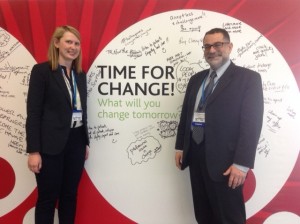Health workers not only count – they are the frontline of health systems improvement

By M. Rashad Massoud, USAID ASSIST Project & University Research Co. and Diana Frymus, USAID
NOTE: This post originally appeared in the USAID ASSISST Project Blog.
This week we appreciate and celebrate those at the frontline of our health systems. With that, let us recognize that there are critical health workforce shortages (7.2 million) which are set to increase to an even higher level of 12.9 million in 20 years. Although many countries have made progress in setting national policies and plans to strengthen the workforce, implementation has been weak and progress has not kept pace with expectations, manifesting in low health worker morale, absenteeism, and high turnover.
During this week, let’s also reflect on the fact that we have proven high-impact interventions to reduce mortality – such as Option B+ to treat the HIV-infected pregnant woman and prevent transmission to her infant – and yet many countries are not on track to meet the maternal health Millennium Development Goals because these are not being implemented reliably. Clearly, beyond 2015 the needs and demands of health systems will only grow.
Let’s get the message out this week that health workers are the change agents of our health systems. They are the best shot we have for getting health systems on track to provide better care, and we have the evidence now to prove it.
By empowering and strengthening health workers to be at the forefront of brainstorming, testing and implementing changes, they can strengthen their systems to achieve better results despite the challenges they face in low resource settings. We’re talking here of building the capability of health workers to apply the science of improvement to improve health care. What have we learned from decades of doing this in low- and middle-income countries, including through the USAID ASSIST Project?
Lesson #1: Health workers perform better when they can define their own roles and responsibilities, organize the way they do their work and determine who does what.
Through our early improvement work, we found that many health workers did not have job descriptions which contributed to a lack of clarity on what they were supposed to do and how they were to engage with their team members in delivery of care. As part of the improvement work, teams of health workers ended up defining their own roles, responsibilities, performance areas and processes. We found that workers became much more aware of what they should be doing, performed better, and as a consequence, the quality of care also improved.
Lesson #2: One stone, many birds: Applying improvement science not only leads to better performance and health care – it improves team work, employee engagement and productivity.
We’ve expanded our focus in this area and now are investigating the effects of applying the science of improvement on health workforce performance, productivity and engagement. It seems that the factors that affect health worker engagement and performance are those that can be addressed through applying improvement approaches. We have seen that the role of the health workforce in improving quality of health care and the role of improvement in addressing common health worker challenges are inextricably intertwined. With USAID and PEPFAR support, ASSIST has conducted multiple studies and developed hands-on tools on health workforce development. A recent study we did in Tanzania found that health facilities with more engaged health workers perform better and are more productive in health and other sectors. Another project in Uganda showed that health workers found ways to improve client waiting times and tracking of active patients by changing the way records are stored. An evaluation of a project in Tanzania found that the average waiting time for HIV services reduced from 76 minutes to 32 minutes, and the time health workers spent in social visits and unexplained absences was eliminated, when previously it was 14% of the working day.
Lesson #3: Empowering health workers through applying improvement science works for all types of health workers, at all levels of the system.
We are now integrating what we learned from the work we have done in improvement at every level of the health system – from the national to sub-national management levels, local facilities, and communities. Using improvement science, we have seen how you can strengthen the capacity of managers, frontline providers, community health workers, and volunteers to manage their own performance, identify strategies for improving care, and monitor and evaluate best practices and health outcome results.
Lesson #4: We have much more to learn: let’s spread and share.
In working with health workers over the years we have generated evidence of what works and doesn’t in order to inform decisions and shape policies. However, there is still a lot to learn from how to improve provider performance within resource-constrained settings. This is where global learning comes in: sharing our own best practices and lessons learned from country experiences; and learning from others through URC and USAID participation in international fora such as the Global Symposium on Health Systems Research and in the development of strategic frameworks like the new PEPFAR FY2014 Quality Strategy. We’d love to hear from you about the work they are doing – why not submit your own improvement story.
As we honor and celebrate health workers worldwide during World Health Worker Week, we do well to keep in mind that empowering and strengthening health workers as change agents at all levels, results in strengthened systems and sustained quality of care.

